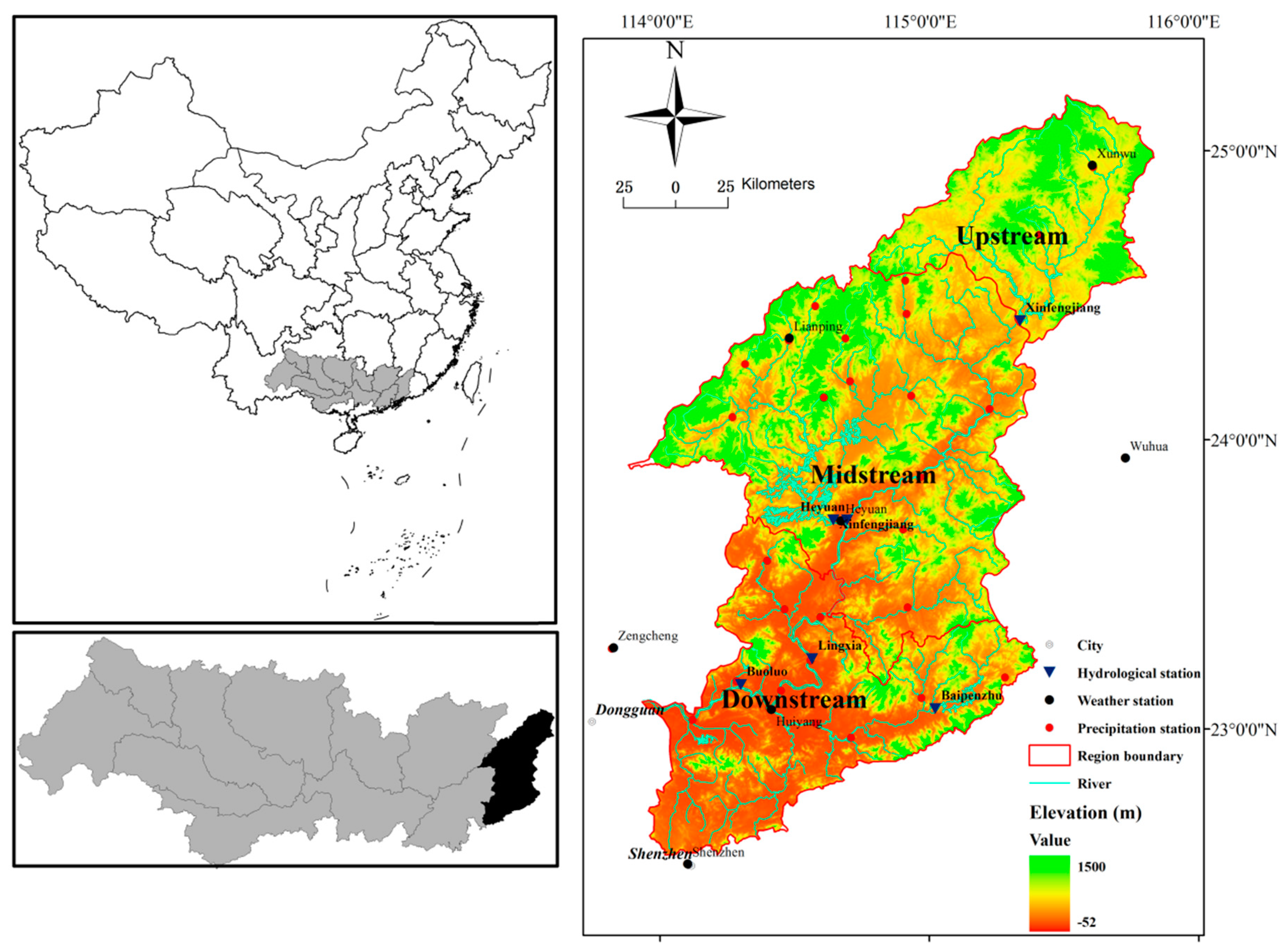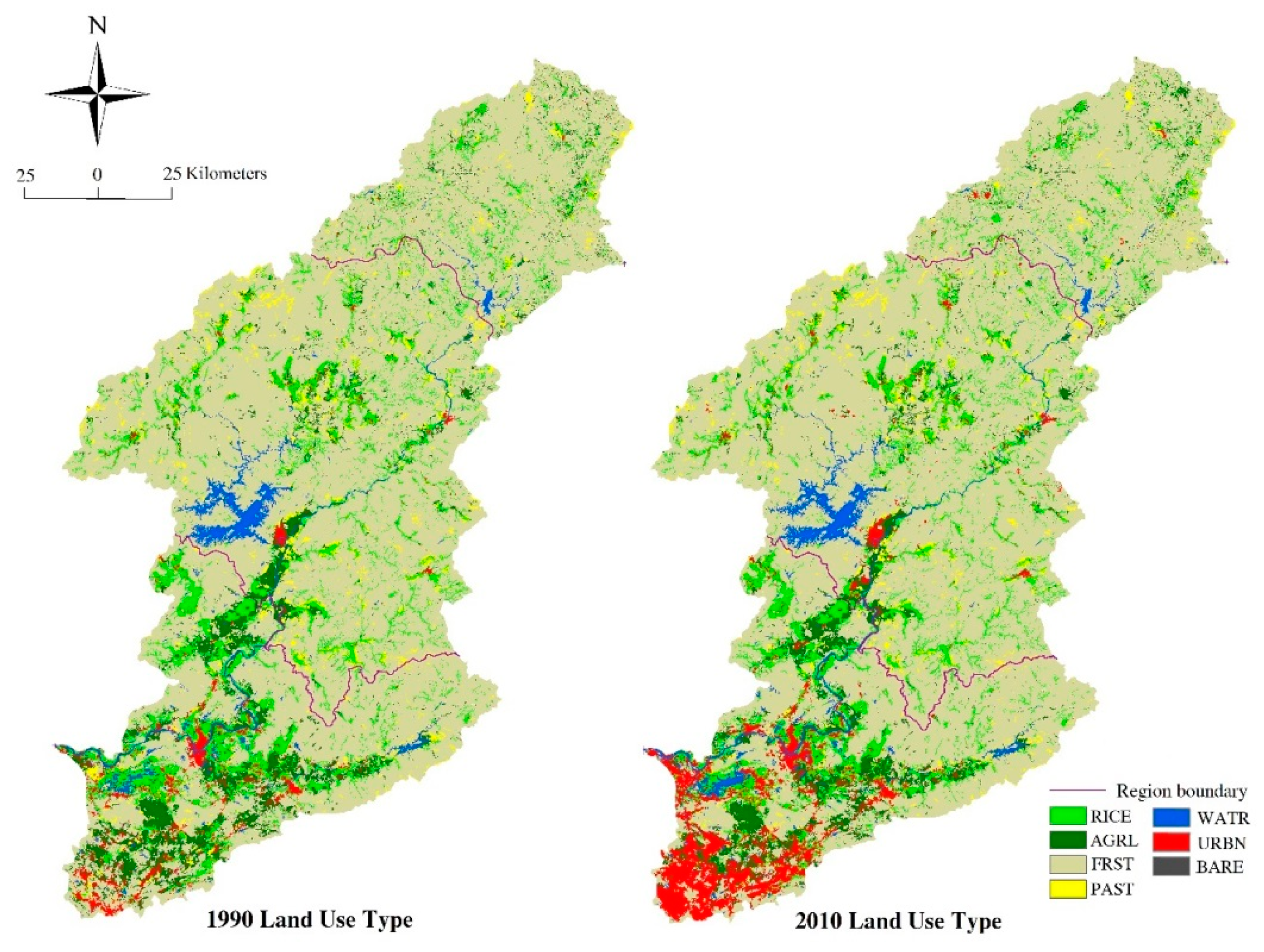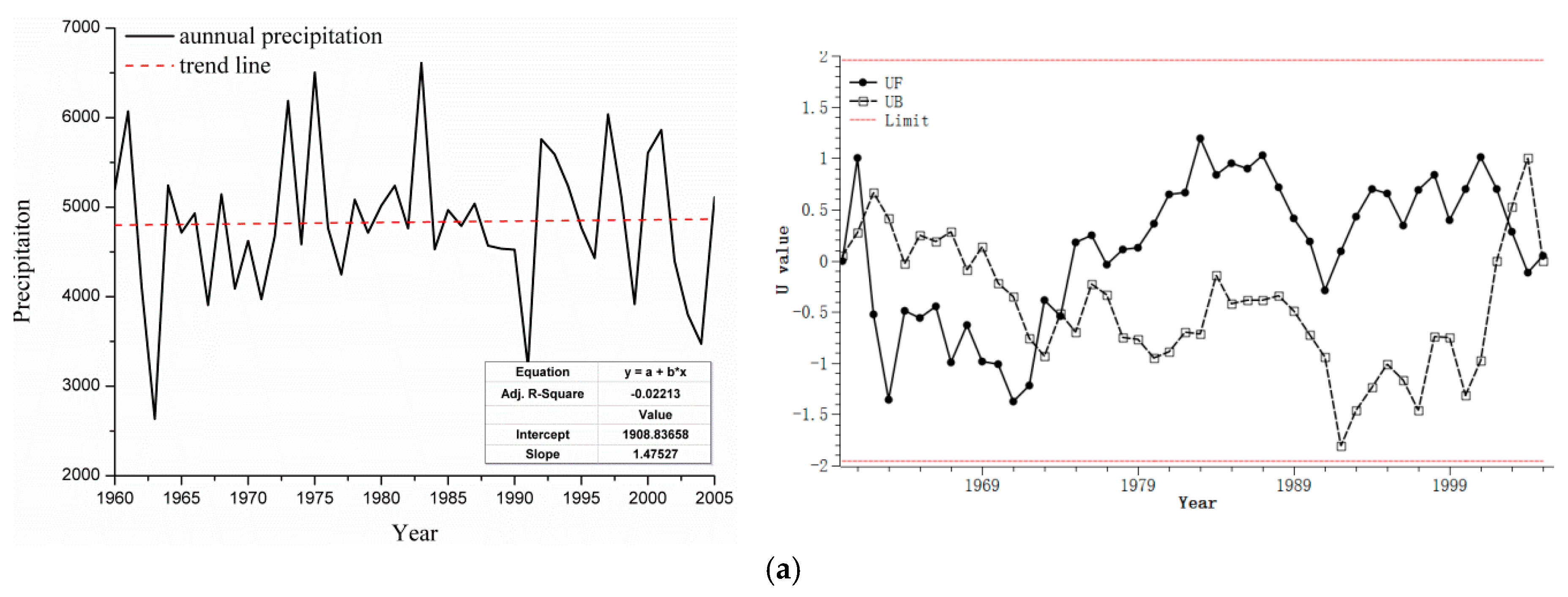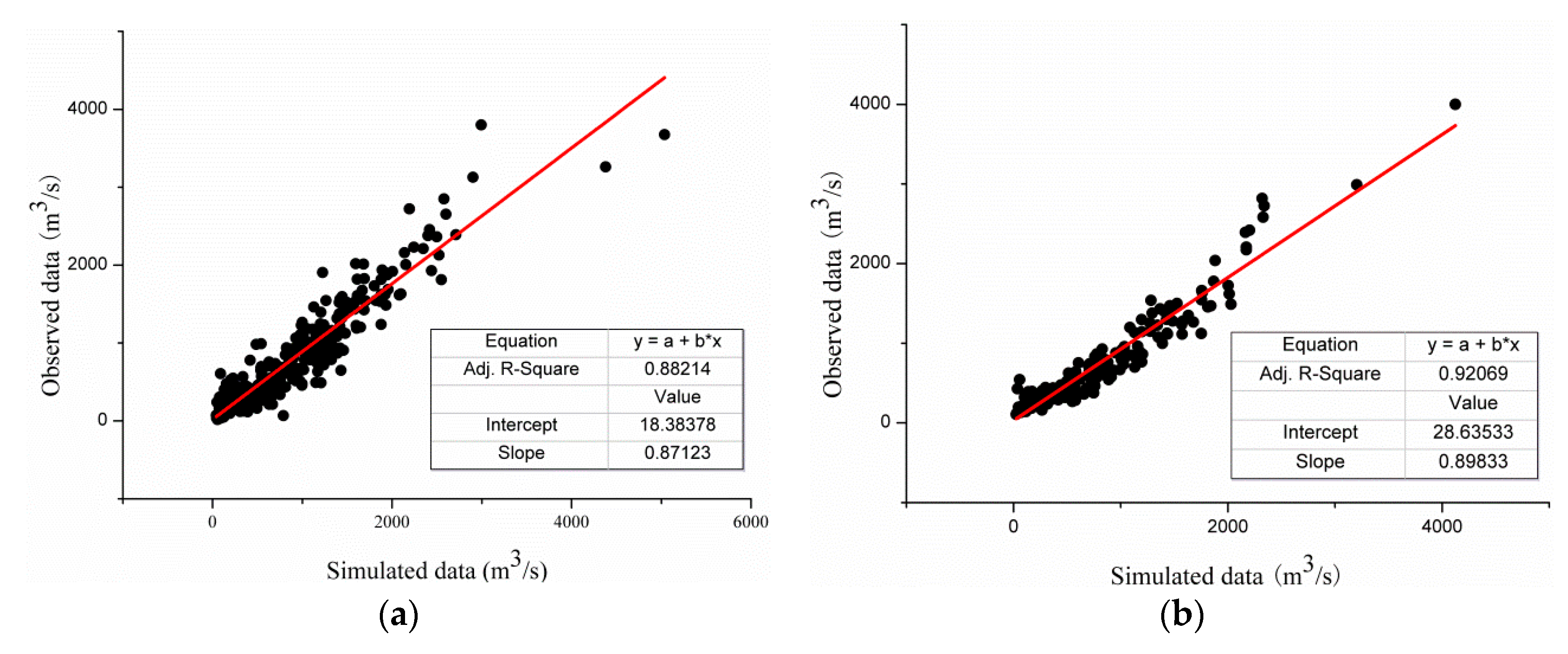Quantitative Evaluation of the Impact of Climate Change and Human Activity on Runoff Change in the Dongjiang River Basin, China
Abstract
:1. Introduction
2. Study Area and Data
2.1. Study Area
2.2. Data
3. Methodology
3.1. Variation Trend Analysis
3.2. Evaluation of Climate and Human Activity Contribution
3.2.1. Linear Regression
3.2.2. Hydrologic Simulation
3.2.3. Climate Elasticity Method
4. Results and Discussion
4.1. Variation Trend and Abrupt Point
4.2. Land Use Change Analysis
4.3. Impacts on Runoff Change
4.3.1. SWAT Calibration and Validation
4.3.2. Contributions of Climate Change and Human Activity to Runoff Change
5. Summary and Conclusions
- (1)
- Annual temperature significantly increased, and pan evaporation significantly decreased in the Dongjiang River basin (95%) from 1960 to 2005. The abrupt points of temperature and pan evaporation series could be detected using the M–K test. We finally established the year 1990 as the critical time point. The natural period ranged from 1960 to 1990, and the affected period ranged from 1991 to 2005.
- (2)
- The percentage of urban area during the natural period, which was 1.94, increased to 4.79 during the affected period. Compared with the upstream and midstream areas, the urban area downstream expanded most rapidly mainly by encroaching into the rice field, agricultural area, and forest land.
- (3)
- All three indexes (i.e., Ens, Re, R2) of the six hydrologic stations fell within the acceptable extent, and the linear fittings between the simulated and actual values were close to 0.9; the peaks of the simulated result were almost synchronous with the peak of precipitation. The performance of the SWAT model applied in the Dongjiang River basin was reasonable and reliable.
- (4)
- The impacts on runoff change induced by human activity in different areas were as follows: 39% in the upstream area; 13% in the midstream area; 77% in the downstream area; and 42% in the whole basin. The human activity in the downstream area exerted greater impacts on runoff change, compared with the upstream and midstream areas. However, for the entire basin, the contribution of climate change (58%) was slightly larger than that of human activity (42%). Therefore, both human activity and climate change should be given considerable attention for the protection, planning, and management of water resources.
Author Contributions
Funding
Conflicts of Interest
References
- Ahn, K.H.; Merwade, V. Quantifying the relative impact of climate and human activities on streamflow. J. Hydrol. 2014, 515, 257–266. [Google Scholar] [CrossRef]
- Lai, C.G.; Shao, Q.X.; Chen, X.H.; Wang, Z.L.; Zhou, X.W.; Yang, B.; Zhang, L. Flood risk zoning using a rule mining based on ant colony algorithm. J. Hydrol. 2016, 542, 268–280. [Google Scholar] [CrossRef]
- Wang, Z.L.; Zeng, Z.Y.; Lai, C.G.; Lin, W.; Wu, X.; Chen, X. A regional frequency analysis of precipitation extremes in Mainland China with fuzzy c-means and L-moments approaches. Int. J. Climatol. 2017, 37, 429–444. [Google Scholar] [CrossRef]
- Cui, P.; Dang, C.; Zhuang, J.Q. Flood disaster monitoring and evaluation in China. Environ. Hazards 2002, 4, 33–43. [Google Scholar]
- Gaume, E.; Basin, V.; Bernardara, P.; Newinger, O.; Barbuc, M.; Bateman, A.; Blaskovicova, L.; Bloschl, G.; Borga, M.; Dumitrescu, A. A compilation of data on European flash floods. J. Hydrol. 2009, 367, 70–78. [Google Scholar] [CrossRef]
- Wang, Z.L.; Lai, C.G.; Chen, X.H.; Yang, B.; Zhao, S.W.; Bai, X.Y. Flood hazard risk assessment model based on random forest. J. Hydrol. 2015, 527, 1130–1141. [Google Scholar] [CrossRef]
- Legesse, D.; Vallet-Coulomb, C.; Gasse, F. Hydrological response of a catchment to climate and land use changes in Tropical Africa: Case study South Central Ethiopia. J. Hydrol. 2003, 275, 67–85. [Google Scholar] [CrossRef]
- Wagener, T.; Sivapalan, M.; Troch, P.A.; McGlynn, B.L.; Harman, C.J.; Gupta, H.V.; Kumar, P.; Rao, P.S.C.; Basu, N.B.; Wilson, J.S. The future of hydrology: An evolving science for a changing world. Water Resour. Res. 2010, 46, 1369–1377. [Google Scholar] [CrossRef]
- Lai, C.G.; Chen, X.H.; Chen, X.Y.; Wang, Z.L.; Wu, X.S.; Zhao, S.W. A fuzzy comprehensive evaluation model for flood risk based on the combination weight of game theory. Nat. Hazards 2015, 77, 1243–1259. [Google Scholar] [CrossRef]
- Milly, P.C.D.; Dunne, K.A.; Vecchia, A.V. Global pattern of trends in streamflow and water availability in a changing climate. Nature 2005, 438, 347–350. [Google Scholar] [CrossRef] [PubMed]
- Mengistu, D.T.; Sorteberg, A. Sensitivity of SWAT simulated streamflow to climatic changes within the Eastern Nile River basin. Hydrol. Earth Syst. Sci. 2012, 16, 391–407. [Google Scholar] [CrossRef]
- Chien, H.; Yeh, J.F.; Knouft, J.H. Modeling the potential impacts of climate change on streamflow in agricultural watersheds of the Midwestern United States. J. Hydrol. 2013, 491, 73–88. [Google Scholar] [CrossRef]
- Tang, Y.; Tang, Q.; Tian, F.; Zhang, Z.; Liu, G. Responses of natural runoff to recent climatic variations in the Yellow River basin, China. Hydrol. Earth Syst. Sci. 2013, 17, 4471–4480. [Google Scholar] [CrossRef]
- Begueria, S.; Lopez-Moreno, J.I.; Lorente, A.; Seeger, M.; Garcia-Ruiz, J.M. Assessing the effect of climate oscillations and land-use changes on streamflow in the central Spanish pyrenees. AMBIO J. Hum. Environ. 2003, 32, 283–286. [Google Scholar] [CrossRef]
- Wang, Z.L.; Xie, P.W.; Lai, C.G.; Chen, X.H.; Zeng, Z.Y.; Li, J. Spatiotemporal variability of reference evapotranspiration and contributing climatic factors in China during 1961–2013. J. Hydrol. 2017, 544, 97–108. [Google Scholar] [CrossRef]
- Zhang, Y.K.; Schilling, K.E. Increasing streamflow and baseflow in Mississippi River since the 1940s: Effect of land use change. J. Hydrol. 2006, 324, 412–422. [Google Scholar] [CrossRef]
- Cho, J.; Barone, V.A.; Mostaghimi, S. Simulation of land use impacts on groundwater levels and streamflow in a Virginia watershed. Agric. Water Manag. 2009, 96, 1–11. [Google Scholar] [CrossRef]
- Randhir, T.O.; Tsvetkova, O. Spatiotemporal dynamics of landscape pattern and hydrologic process in watershed systems. J. Hydrol. 2011, 404, 1–12. [Google Scholar] [CrossRef]
- Renner, M.; Brust, K.; Schwaerzel, K.; Volk, M.; Bernhofer, C. Separating the effects of changes in land cover and climate: A hydro-meteorological analysis of the past 60 year in Saxony, Germany. Hydrol. Earth Syst. Sci. 2013, 10, 8537–8580. [Google Scholar] [CrossRef]
- Rougé, C.; Cai, X. Crossing-scale hydrological impacts of urbanization and climate variability in the Greater Chicago Area. J. Hydrol. 2014, 517, 13–27. [Google Scholar] [CrossRef]
- Huntingford, C.; Marsh, T.; Scaife, A.A.; Kendon, E.J.; Hannaford, J.; Kay, A.L.; Lockwood, M.; Prudhomme, C.; Reynard, N.S.; Parry, S. Potential influences on the United Kingdoms floods of winter 2013/14. Nat. Clim. Chang. 2014, 4, 769–777. [Google Scholar] [CrossRef]
- Kelly, M.; Michael, A.A.; Gregory, T.; Joseph, J.B.; James, D.S. Changes in hail and flood risk in high-resoulution simulations over Colorado’s mountains. Nat. Clim. Chang. 2012, 2, 125–131. [Google Scholar]
- Sterling, M.S.; Ducharne, A.; Polcher, J. The impact of global land-cover change on the terrestrial water cycle. Nat. Clim. Chang. 2013, 3, 385–390. [Google Scholar] [CrossRef]
- Lu, S.L.; Wu, B.F.; Wei, Y.P.; Yan, N.N.; Wang, H.; Guo, S.Y. Quantifying impacts of climate variability and human activities on the hydrological system of the Haihe River Basin, China. Environ. Earth Sci. 2015, 73, 1491–1503. [Google Scholar] [CrossRef]
- Li, L.J.; Zhang, L.; Wang, H.; Wang, J.; Yang, J.W.; Jiang, D.J.; Li, J.Y.; Qin, D.Y. Assessing the impact of climate variability and human activities on streamflow from the Wuding River basin in China. Hydrol. Process. 2007, 21, 3485–3491. [Google Scholar] [CrossRef]
- Cioffi, F.; Conticello, F.; Lall, U.; Marotta, L.; Telesca, V. Large scale climate and rainfall seasonality in a Mediterranean Area: Insights from a non-homogeneous Markov model applied to the Agro-Pontino plain. Hydrol. Process. 2017, 31, 668–686. [Google Scholar] [CrossRef]
- Neiva, H.D.S.; da Silva, M.S.; Cardoso, C. Analysis of climate behavior and land use in the city of Rio de Janeiro, RJ, Brazil. Climate 2017, 5, 52. [Google Scholar] [CrossRef]
- Pan, S.; Liu, D.; Wang, Z.; Zhao, Q.; Zou, H.; Hou, Y.; Liu, P.; Xiong, L. Runoff responses to climate and land use/cover changes under future scenarios. Water 2017, 9, 475. [Google Scholar] [CrossRef]
- Fu, G.; Charles, S.P.; Chiew, F.H.S. A two-parameter climate elasticity of streamflow index to assess climate change effects on annual streamflow. Water Resour. Res. 2007, 43, 2578–2584. [Google Scholar] [CrossRef]
- Zhan, C.S.; Jiang, S.S.; Sun, F.B.; Jia, Y.W.; Niu, C.W.; Yue, W.F. Quantitative contribution of climate change and human activities to runoff changes in the Wei River basin, China. Hydrol. Earth Syst. Sci. 2014, 11, 2149–2175. [Google Scholar] [CrossRef]
- Guo, H.; Hu, Q.; Jiang, T. Annual and seasonal streamflow responses to climate and land-cover changes in the Poyang Lake basin, China. J. Hydrol. 2008, 355, 106–122. [Google Scholar] [CrossRef]
- Ha, L.T.; Bastiaanssen, W.G.M.; van Griensven, A.; van Dijk, A.I.J.M.; Senay, G.B. Calibration of Spatially Distributed Hydrological Processes and Model Parameters in SWAT Using Remote Sensing Data and an Auto-Calibration Procedure: A Case Study in a Vietnamese River Basin. Water 2018, 10, 212. [Google Scholar] [CrossRef]
- Bajracharya, A.R.; Bajracharya, S.R.; Shrestha, A.B.; Maharjan, S.B. Climate change impact assessment on the hydrological regime of the Kaligandaki Basin, Nepal. Sci. Total Environ. 2018, 625, 837–848. [Google Scholar] [CrossRef] [PubMed]
- Bao, Z.X.; Zhang, J.Y.; Wang, G.Q.; Fu, G.B.; He, R.M.; Yan, X.L.; Jin, J.L.; Liu, Y.L.; Zhang, A.J. Attribution for de-creasing runoff of the Haihe River baisn, northern China: Climate variability or human activities? J. Hydrol. 2012, 460–461, 117–129. [Google Scholar] [CrossRef]
- Wang, Z.L.; Zhong, R.D.; Lai, C.G. Evaluation and hydrologic validation of TMPA satellite precipitation product downstream of the Pearl River Basin, China. Hydrol. Process. 2017, 31, 4169–4182. [Google Scholar] [CrossRef]
- Wang, Z.L.; Zhong, R.D.; Lai, C.G.; Chen, J.C. Evaluation of the GPM IMERG satellite-based precipitation products and the hydrological utility. Atmos. Res. 2017, 196, 151–163. [Google Scholar] [CrossRef]
- Teng, F.; Huang, W.R.; Ginis, I. Hydrological modeling of storm runoff and snowmelt in Taunton River Basin by applications of HEC-HMS and PRMS models. Nat. Hazards 2018, 91, 179–199. [Google Scholar] [CrossRef]
- Dvory, N.Z.; Ronen, A.; Livshitz, Y.; Adar, E.; Kuznetsov, M.; Yakirevich, A. Quantification of Groundwater Recharge from an Ephemeral Stream into a Mountainous Karst Aquifer. Water 2018, 10, 79. [Google Scholar] [CrossRef]
- Tu, J. Combined impact of climate and land use changes on streamflow and water quality in eastern Massachusetts, USA. J. Hydrol. 2009, 379, 268–283. [Google Scholar] [CrossRef]
- Wu, R.S.; Lin, I.W. Modification of generalized watershed loading functions (GWLF) for daily flow simulation. Paddy Water Environ. 2015, 13, 269–279. [Google Scholar] [CrossRef]
- Liu, D.; Chen, X.; Lian, Y.; Lou, Z.H. Impacts of climate change and human activities on surface runoff in the Dongjiang River basin of China. Hydrol. Process. 2010, 24, 1487–1495. [Google Scholar] [CrossRef]
- Lai, C.G.; Wang, Z.L.; Chen, X.H.; Xu, C.-Y.; Yang, B.; Meng, Q.Q.; Huang, B. A procedure for assessing the impacts of land-cover change on soil erosion at basin scale. Hydrol. Res. 2016, 47, 903–918. [Google Scholar] [CrossRef]
- Wang, Z.L.; Zhong, R.D.; Lai, C.G.; Zeng, Z.Y.; Lian, Y.Q.; Bai, X.Y. Climate change enhances the severity and variability of drought in the Pearl River Basin in South China in the 21st century. Agric. For. Meteorol. 2018, 249, 149–162. [Google Scholar] [CrossRef]
- Lai, C.G.; Chen, X.H.; Wang, Z.L.; Wu, X.S.; Zhao, S.W.; Wu, X.Q.; Bai, W.K. Spatio-temporal variation in rainfall erosivity during 1960–2012 in the Pearl River Basin, China. Catena 2016, 137, 382–391. [Google Scholar] [CrossRef]
- Reder, A.; Rianna, G.; Vezzoli, R.; Mercogliano, P. Assessment of possible impacts of climate change on the hydrological regimes of different regions in China. Adv. Clim. Chang. Res. 2016, 7, 169–184. [Google Scholar] [CrossRef]
- He, Y.H.; Lin, K.R.; Chen, X.H. Effect of land use and climate change on runoff in the Dongjiang Basin of South China. Math. Probl. Eng. 2013, 2013, 471429. [Google Scholar] [CrossRef]
- Wang, Z.L.; Li, J.; Lai, C.G.; Wang, R.Y.; Chen, X.H.; Lian, Y.Q. Drying tendency dominating the global grain production area. Glob. Food Secur. 2018, 16, 138–149. [Google Scholar] [CrossRef]
- Wu, X.S.; Wang, Z.L.; Zhou, X.W.; Zeng, Z.Y.; Lai, C.G.; Chen, X.H. Variability of annual peak flows in the Beijiang River Basin, South China, and possible underlying causes. Hydrol. Res. 2017, 48, 442–454. [Google Scholar] [CrossRef]
- Wang, Z.L.; Li, J.; Lai, C.G.; Zeng, Z.Y.; Zhong, R.D.; Chen, X.H.; Zhou, X.W.; Wang, M.Y. Does drought in China show a significant decreasing trend from 1961 to 2009? Sci. Total Environ. 2016, 579, 314–324. [Google Scholar] [CrossRef] [PubMed]
- Jiang, S.; Ren, L.; Yong, B.; Singh, V.P.; Yang, X.L.; Yuan, F. Quantifying the effects of climate variability and human activities on runoff from the Laohahe basin in northern China using three different methods. Hydrol. Process. 2011, 25, 2492–2505. [Google Scholar] [CrossRef]
- Hu, S.S.; Zheng, H.X.; Liu, C.M.; Yu, J.J.; Wang, Z.G. Assessing the impacts of climate variability and human activities on streamflow in the water source area of Baiyangdian Lake. Acta Geogr. Sin. 2012, 67, 62–70. [Google Scholar] [CrossRef]
- Zhang, L.; Dawes, W.R.; Walker, G.R. Response of mean annual evapotranspiration to vegetation changes at catchment scale. Water Resour. Res. 2001, 37, 701–708. [Google Scholar]
- Liu, X.P.; Li, X.; Liu, L.; He, J.; Ai, B. An innovative method to classify remotesensing images using ant colony optimization. IEEE Trans. Geosci. Remote Sens. 2008, 46, 4198–4208. [Google Scholar] [CrossRef]
- Liu, X.; Liang, X.; Li, X.; Xu, X.; Ou, J.; Chen, Y.; Li, S.; Wang, S.; Pei, F. A future land use simulation model (FLUS) for simulating multiple land use scenarios by coupling human and natural effects. Landsc. Urban Plan. 2017, 168, 94–116. [Google Scholar] [CrossRef]






| 1990/2010 | RICE | AGRC | FRST | PAST | WATR | URBN | BARE | Total Rate (2010) |
|---|---|---|---|---|---|---|---|---|
| RICE | 9.59 | 0.11 | 1.07 | 0.11 | 0.06 | 0.09 | 0.00 | 11.03 |
| AGRC | 0.09 | 4.72 | 0.53 | 0.05 | 0.03 | 0.04 | 0.00 | 5.46 |
| FRST | 1.11 | 0.51 | 70.10 | 0.60 | 0.19 | 0.07 | 0.00 | 72.58 |
| PAST | 0.09 | 0.04 | 0.32 | 2.87 | 0.02 | 0.01 | 0.00 | 3.35 |
| WATR | 0.15 | 0.05 | 0.22 | 0.03 | 2.33 | 0.02 | 0.00 | 2.8 |
| URBN | 0.67 | 0.91 | 1.24 | 0.20 | 0.06 | 1.71 | 0.00 | 4.79 |
| BARE | 0.00 | 0.00 | 0.00 | 0.00 | 0.00 | 0.00 | 0.00 | 0 |
| Total rate (1990) | 11.7 | 6.34 | 73.48 | 3.86 | 2.69 | 1.94 | 0 |
| Upstream | Rate (%) | Midstream | Rate (%) | Downstream | Rate (%) | |
|---|---|---|---|---|---|---|
| 1→1 | 537 | 6.71 | 1788 | 8.61 | 1792 | 13.79 |
| 1→2 | 2 | 0.02 | 13 | 0.06 | 16 | 0.12 |
| 1→3 | 89 | 1.11 | 232 | 1.12 | 80 | 0.62 |
| 1→4 | 5 | 0.06 | 29 | 0.14 | 1 | 0.01 |
| 1→5 | 0 | 0.00 | 7 | 0.03 | 55 | 0.42 |
| 1→6 | 4 | 0.05 | 41 | 0.20 | 235 | 1.81 |
| 1→7 | 0 | 0.00 | 0 | 0.00 | 0 | 0.00 |
| 2→1 | 8 | 0.10 | 16 | 0.08 | 22 | 0.17 |
| 2→2 | 222 | 2.77 | 518 | 2.49 | 1216 | 9.36 |
| 2→3 | 47 | 0.59 | 81 | 0.39 | 78 | 0.60 |
| 2→4 | 2 | 0.02 | 9 | 0.04 | 3 | 0.02 |
| 2→5 | 0 | 0.00 | 3 | 0.01 | 17 | 0.13 |
| 2→6 | 1 | 0.01 | 32 | 0.15 | 360 | 2.77 |
| 2→7 | 0 | 0.00 | 0 | 0.00 | 0 | 0.00 |
| 3→1 | 101 | 1.26 | 245 | 1.18 | 92 | 0.71 |
| 3→2 | 77 | 0.96 | 66 | 0.32 | 76 | 0.58 |
| 3→3 | 6592 | 82.38 | 15,713 | 75.63 | 7019 | 54.02 |
| 3→4 | 14 | 0.17 | 105 | 0.51 | 15 | 0.12 |
| 3→5 | 10 | 0.12 | 46 | 0.22 | 31 | 0.24 |
| 3→6 | 12 | 0.15 | 50 | 0.24 | 470 | 3.62 |
| 3→7 | 0 | 0.00 | 0 | 0.00 | 0 | 0.00 |
| 4→1 | 6 | 0.07 | 33 | 0.16 | 7 | 0.05 |
| 4→2 | 2 | 0.02 | 18 | 0.09 | 9 | 0.07 |
| 4→3 | 14 | 0.17 | 173 | 0.83 | 58 | 0.45 |
| 4→4 | 164 | 2.05 | 779 | 3.75 | 254 | 1.95 |
| 4→5 | 2 | 0.02 | 3 | 0.01 | 9 | 0.07 |
| 4→6 | 1 | 0.01 | 16 | 0.08 | 55 | 0.42 |
| 4→7 | 0 | 0.00 | 0 | 0.00 | 0 | 0.00 |
| 5→1 | 1 | 0.01 | 4 | 0.02 | 22 | 0.17 |
| 5→2 | 1 | 0.01 | 7 | 0.03 | 6 | 0.05 |
| 5→3 | 7 | 0.09 | 55 | 0.26 | 14 | 0.11 |
| 5→4 | 0 | 0.00 | 5 | 0.02 | 2 | 0.02 |
| 5→5 | 62 | 0.77 | 557 | 2.68 | 396 | 3.05 |
| 5→6 | 0 | 0.00 | 1 | 0.00 | 22 | 0.17 |
| 5→7 | 0 | 0.00 | 0 | 0.00 | 0 | 0.00 |
| 6→1 | 0 | 0.00 | 0 | 0.00 | 1 | 0.01 |
| 6→2 | 0 | 0.00 | 0 | 0.00 | 0 | 0.00 |
| 6→3 | 1 | 0.01 | 0 | 0.00 | 2 | 0.02 |
| 6→4 | 0 | 0.00 | 0 | 0.00 | 0 | 0.00 |
| 6→5 | 0 | 0.00 | 0 | 0.00 | 4 | 0.03 |
| 6→6 | 3 | 0.04 | 53 | 0.26 | 200 | 1.54 |
| 6→7 | 0 | 0.00 | 0 | 0.00 | 19 | 0.15 |
| 7→1 | 1 | 0.01 | 4 | 0.02 | 8 | 0.06 |
| 7→2 | 1 | 0.01 | 2 | 0.01 | 16 | 0.12 |
| 7→3 | 1 | 0.01 | 2 | 0.01 | 4 | 0.03 |
| 7→4 | 0 | 0.00 | 0 | 0.00 | 4 | 0.03 |
| 7→5 | 0 | 0.00 | 0 | 0.00 | 303 | 2.33 |
| 7→6 | 12 | 0.15 | 71 | 0.34 | 0 | 0.00 |
| 7→7 | 0 | 0.00 | 0 | 0.00 | 0 | 0.00 |
| Parameter | Input Data | Definition | Lower Limit | Upper Limit |
|---|---|---|---|---|
| CN2 | .mgt | Initial SCS curve CNII value | 35 | 98 |
| ESCO | .hru | Soil evaporation compensation factor | 0 | 1 |
| CANMX | .hru | Maximum canopy storage | 0 | 100 |
| ALPHA_BF | .gw | Baseflow alpha factor | 0 | 1 |
| GW_DELAY | .gw | Groundwater delay time | 0 | 500 |
| GWQMN | .gw | Threshold water depth in shallow aquifer | 0 | 5000 |
| SOL_AWC | .sol | Available water capacity | 0 | 1 |
| Station | Period | Ens | Re | R2 |
|---|---|---|---|---|
| Fengshuba | Natural period | 0.79 | 2.26% | 0.80 |
| Affected period | 0.76 | 14.50% | 0.82 | |
| Xinfengjiang | Natural period | 0.78 | 5.03% | 0.79 |
| Affected period | 0.90 | 9.09% | 0.91 | |
| Heyuan | Natural period | 0.70 | 11.87% | 0.77 |
| Affected period | 0.86 | 7.10% | 0.89 | |
| Lingxia | Natural period | 0.91 | 7.56% | 0.92 |
| Affected period | 0.93 | 7.29% | 0.94 | |
| Baipenzhu | Natural period | 0.80 | 17.02% | 0.77 |
| Affected period | 0.73 | 8.12% | 0.75 | |
| Boluo | Natural period | 0.84 | 12.07% | 0.88 |
| Affected period | 0.90 | 7.06% | 0.92 |
| Evaluation Index | Ens | Cor | ||
|---|---|---|---|---|
| Linear Regression | SWAT Model | Linear Regression | SWAT Model | |
| Dongjiang River basin | 0.86 * | 0.85 | 0.86 * | 0.89 |
| Upstream | 0.66 * | 0.79 | 0.68 * | 0.81 |
| Midstream | 0.71 * | 0.82 | 0.72 * | 0.84 |
| Downstream | 0.64 * | 0.77 | 0.66 * | 0.79 |
| Contribution (%)-Human Activity/Climate Change | Linear Regression | SWAT Model | Climate Elasticity Method | Average |
|---|---|---|---|---|
| Dongjiang River basin | 49/51 | 42/58 | 36/64 | 42/58 |
| Upstream | 34/66 | 46/54 | 37/63 | 39/61 |
| Midstream | 6/94 | 30/70 | 3/97 | 13/87 |
| Downstream | 87/13 | 61/39 | 84/16 | 77/23 |
| Region | Precipitation Change | Runoff Coefficient in Natural Period | Runoff Coefficient in Affected Period | Runoff Coefficient Change |
|---|---|---|---|---|
| Upstream | −13.55 | 0.608 | 0.510 | −0.097 |
| Midstream | −12.42 | 0.588 | 0.560 | −0.028 |
| Downstream | −7.11 | 0.459 | 0.465 | 0.006 |
| Region | 1990 POP () | 2010 POP () | POP Total Change | 1990 GDP () | 2010 GDP () | GDP Total Change |
|---|---|---|---|---|---|---|
| Upstream | 144.7321 | 169.3241 | 24.592 | 24.60954 | 156.9948 | 132.3853 |
| Midstream | 171.9268 | 209.1669 | 37.2401 | 39.14305 | 332.22 | 293.077 |
| Downstream | 285.2654 | 452.7741 | 167.5087 | 610.2614 | 3672.307 | 3062.046 |
© 2018 by the authors. Licensee MDPI, Basel, Switzerland. This article is an open access article distributed under the terms and conditions of the Creative Commons Attribution (CC BY) license (http://creativecommons.org/licenses/by/4.0/).
Share and Cite
Zhou, Y.; Lai, C.; Wang, Z.; Chen, X.; Zeng, Z.; Chen, J.; Bai, X. Quantitative Evaluation of the Impact of Climate Change and Human Activity on Runoff Change in the Dongjiang River Basin, China. Water 2018, 10, 571. https://doi.org/10.3390/w10050571
Zhou Y, Lai C, Wang Z, Chen X, Zeng Z, Chen J, Bai X. Quantitative Evaluation of the Impact of Climate Change and Human Activity on Runoff Change in the Dongjiang River Basin, China. Water. 2018; 10(5):571. https://doi.org/10.3390/w10050571
Chicago/Turabian StyleZhou, Yuliang, Chengguang Lai, Zhaoli Wang, Xiaohong Chen, Zhaoyang Zeng, Jiachao Chen, and Xiaoyan Bai. 2018. "Quantitative Evaluation of the Impact of Climate Change and Human Activity on Runoff Change in the Dongjiang River Basin, China" Water 10, no. 5: 571. https://doi.org/10.3390/w10050571






